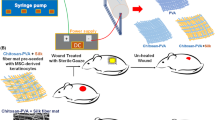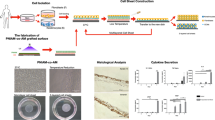Abstract
This work developed a novel bi-layer wound dressing composed of 3D activated carbon fibers that allows facilitates fibroblast cell growth and migration to a wound site for tissue reconstruction, and the gentamicin is incorporated into a poly(γ-glutamic acid)/gelatin membrane to prevent bacterial infection. In an in vitro, field emission scanning electron microscopy shows that rat skin fibroblasts appeared and spread on the surface of activated carbon fibers, and penetrated the interior and exterior of the 3D activated carbon fiber construct to a depth of roughly 200 μm. An in vivo analysis shows that fibroblast cells containing the proposed 3D scaffold had the potential of a biologically functionalized dressing to accelerate wound closure. Additionally, fibroblasts migrated to the wound site in a bi-layer wound dressing containing fibroblasts, enhancing fibronectin and type I collagen expression, resulting in faster skin regeneration than that achieved with a Tegaderm™ hydrocolloid dressing or gauze.








Similar content being viewed by others
References
Chung AS, Kao WJ. Fibroblasts regulate monocyte response to ECM-derived matrix: the effects on monocyte adhesion and the production of inflammatory, matrix remodeling, and growth factor proteins. J Biomed Mater Res A. 2009;89:841–53.
Liang Y, Liu W, Han B, Yang C, Ma Q, Zhao W, Rong M, Li H. Fabrication and characters of a corneal endothelial cells scaffold based on chitosan. J Mater Sci Mater Med. 2011;22:175–83.
Gong F, Cheng X, Wang S, Zhao Y, Gao Y, Cai H. Heparin-immobilized polymers as non-inflammatory and non-thrombogenic coating materials for arsenic trioxide eluting stents. Acta Biomater. 2010;6:534–46.
Velander P, Theopold C, Bleiziffer O, Bergmann J, Svensson H, Feng Y, Eriksson E. Cell suspensions of autologous keratinocytes or autologous fibroblasts accelerate the healing of full thickness skin wounds in a diabetic porcine wound healing model. J Surg Res. 2009;157:14–20.
Dasdia T, Bazzaco S, Bottero L, Buffa R, Ferrero S, Campanelli G, Dolfini E. Organ culture in 3-dimensional matrix: in vitro model for evaluating biological compliance of synthetic meshes for abdominal wall repair. J Biomed Mater Res. 1998;43:204–9.
Ishaug SL, Crane GM, Miller MJ, Yasko AW, Yaszemski MJ, Mikos AG. Bone formation by three-dimensional stromal osteoblast culture in biodegradable polymer scaffolds. J Biomed Mater Res. 1997;36:17–28.
Whang K, Thomas CH, Healy KE. A novel method to fabricate bioabsorbable scaffolds. Polymer. 1995;36:837–42.
Mikos AG, Thorsen AJ, Czerwonka LA, Bao Y, Langer R, Winslow DN. Preparation and characterization of poly(l-lactic acid) foams. Polymer. 1994;35:1068–77.
Nam YS, Park TG. Biodegradable polymeric microcellular foams by modified thermally induced phase separation method. Biomaterials. 1999;20:1783–90.
Maspero FA, Ruffieux K, Müller B, Wintermantel E. Resorbable defect analog PLGA scaffolds using CO2 as solvent: structural characterization. J Biomed Mater Res. 2002;62:89–98.
Osswald S, Yushin G, Mochalin V, Kucheyev SO, Gogotsi Y. Control of sp 2/sp 3 carbon ratio and surface chemistry of nanodiamond powders by selective oxidation in air. J Am Chem Soc. 2006;128:11635–42.
Hayden LA, Watson EB. Grain boundary mobility of carbon in earth’s mantle: a possible carbon flux from the core. Proc Natl Acad Sci USA. 2008;105:8537–41.
Kwiecinska B, Petersen HI. Graphite, semi-graphite, natural coke, and natural char classification-ICCP system. Int J Coal Geol. 2004;57:99–116.
Lin JH, Ko TH, Lin YH, Pan CK. Various treated conditions to prepare porous activated carbon fiber for application in super capacitor electrodes. Energy Fuels. 2009;23:4668–77.
Lee J, Kim J, Hyeon T. Recent progress in the synthesis of porous carbon materials. Adv Mater. 2006;18:2073–94.
Le Pape H, Solano-Serena F, Contini P, Devillers C, Maftah A, Leprat P. Involvement of reactive oxygen species in the bactericidal activity of activated carbon fibre supporting silver; bactericidal activity of ACF(Ag) mediated by ROS. J Inorg Biochem. 2004;98:1054–60.
Chakravarthi A, Srinivas CR, Mathew AC. Activated charcoal and baking soda to reduce odor associated with extensive blistering disorders. Indian J Dermatol Venereol Leprol. 2008;74:122–4.
Du XN, Niu Z, Zhou GZ, Li ZM. Effect of activated charcoal on endotoxin adsorption. Part I. An in vitro study. Biomater Artif Cells Artif Organs. 1987;15:229–35.
Yushin G, Hoffman EN, Barsoum MW, Gogotsi Y, Howell CA, Sandeman SR, Phillips GJ, Lloyd AW, Mikhalovsky SV. Mesoporous carbide-derived carbon with porosity tuned for efficient adsorption of cytokines. Biomaterials. 2006;27:5755–62.
Cieślik M, Mertas A, Morawska-Chochól A, Sabat D, Orlicki R, Owczarek A, Król W, Cieślik T. The evaluation of the possibilities of using PLGA co-polymer and its composites with carbon fibers or hydroxyapatite in the bone tissue regeneration process-in vitro and in vivo examinations. Int J Mol Sci. 2009;10:3224–34.
McKenzie JL, Waid MC, Shi R, Webster TJ. Decreased functions of astrocytes on carbon nanofiber materials. Biomaterials. 2004;25:1309–17.
Viguier E, Bignon A, Laurent F, Goehrig D, Boivin G, Chevalier J. A new concept of gentamicin loaded HAP/TCP bone substitute for prophylactic action: in vivo pharmacokinetic study. J Mater Sci Mater Med. 2011;22:879–86.
Elsner JJ, Berdicevsky I, Zilberman M. In vitro microbial inhibition and cellular response to novel biodegradable composite wound dressings with controlled release of antibiotics. Acta Biomater. 2011;7:325–36.
Pavlukhina S, Lu Y, Patimetha A, Libera M, Sukhishvili S. Polymer multilayers with pH-triggered release of antibacterial agents. Biomacromolecules. 2010;11:3448–56.
Junge K, Klinge U, Rosch R, Lynen P, Binnebösel M, Conze J, Mertens PR, Schwab R, Schumpelick V. Improved collagen type I/III ratio at the interface of gentamicin-supplemented polyvinylidenfluoride mesh materials. Langenbecks Arch Surg. 2007;392:465–71.
Lin YH, Lin JH, Peng SF, Yeh CL, Chen WC, Chang TL, Liu MJ, Lai CH. Multifunctional gentamicin supplementation of poly(γ-glutamic acid)-based hydrogels for wound dressing application. J Appl Polym Sci. 2011;120:1057–68.
Rnjak J, Li Z, Maitz PK, Wise SG, Weiss AS. Primary human dermal fibroblast interactions with open weave three-dimensional scaffolds prepared from synthetic human elastin. Biomaterials. 2009;30:6469–77.
Stephanson CJ, Flanagan GP. Antioxidant capacity of silica hydride: a combinational photosensitization and fluorescence detection assay. Free Radic Biol Med. 2003;35:1129–37.
Lee WR, Park JH, Kim KH, Kim SJ, Park DH, Chae MH, Suh SH, Jeong SW, Park KK. The biological effects of topical alginate treatment in an animal model of skin wound healing. Wound Repair Regen. 2009;17:505–10.
Balakrishnan B, Mohanty M, Fernandez AC, Mohanan PV, Jayakrishnan A. Evaluation of the effect of incorporation of dibutyryl cyclic adenosine monophosphate in an in situ-forming hydrogel wound dressing based on oxidized alginate and gelatin. Biomaterials. 2006;27:1355–61.
Richard A, Margaritis A. Poly(glutamic acid) for biomedical applications. Crit Rev Biotechnol. 2001;21:219–32.
Pal K, Banthia AK, Majumdar DK. Biomedical evaluation of polyvinyl alcohol-gelatin esterified hydrogel for wound dressing. J Mater Sci Mater Med. 2007;18:1889–94.
Petrenko YA, Ivanov RV, Petrenko AY, Lozinsky VI. Coupling of gelatin to inner surfaces of pore walls in spongy alginate-based scaffolds facilitates the adhesion, growth and differentiation of human bone marrow mesenchymal stromal cells. J Mater Sci Mater Med. 2011;22:1529–40.
Izumi Y, Yamamoto M, Kawamura M, Adachi T, Kobayashi K. Cross-linked poly (gamma-glutamic acid) attenuates peritoneal adhesion in a rat model. Surgery. 2007;141:678–81.
Matsushita A, Iwase M, Kato Y, Ichihara S, Ichihara G, Kimata H, Hayashi K, Hashimoto K, Yokoi T, Noda A, Koike Y, Yokota M, Nagata K. Differential cardiovascular effects of endotoxin derived from Escherichia coli or Pseudomonas aeruginosa. Exp Anim. 2007;56:339–48.
Karyoute SM. Burn wound infection in 100 patients treated in the burn unit at Jordan university hospital. Burns. 1898;15:117–9.
Bryan LE, Van Den Elzen HM. Effects of membrane-energy mutations and cations on streptomycin and gentamicin accumulation by bacteria: a model for entry of streptomycin and gentamicin in susceptible and resistant bacteria. Antimicrob Agents Chemother. 1977;12:163–77.
Yoshizawa S, Fourmy D, Puglisi JD. Structural origins of gentamicin antibiotic action. EMBO J. 1998;17:6437–48.
Nayak S, Nalabothu P, Sandiford S, Bhogadi V, Adogwa A. Evaluation of wound healing activity of Allamanda cathartica L. and Laurus nobilis L. extracts on rats. BMC Complement Altern Med. 2006;6:12–7.
Sardari K, Kakhki EG, Mohri M. Evaluation of wound contraction and epithelialization after subcutaneous administration of Theranekron® in cows. Comp Clin Pathol. 2007;16:197–200.
Nodder S, Martin P. Wound healing in embryos: a review. Anat Embryol. 1997;195:215–28.
Sardari K, Sharifi S. Effect of collagen cross-linking inhibition by local application of beta-aminopropionitrile fumarate on wound contraction and healing (macroscopic study). Comp Clin Pathol. 2008;17:179–83.
Stashak TS, Farstvedt E, Othic A. Update on wound dressing: indications and best use. Clin Tech Equine Pract. 2004;3:148–63.
Kerihuel JC. Effect of activated charcoal dressings on healing outcomes of chronic wounds. J Wound Care. 2010;19:208–14.
Ghasemi-Mobarakeh L, Prabhakaran M, Morshed M, Nasr-Esfahani MH, Ramakrishna S. Electrospun poly(epsilon-caprolactone)/gelatin nanofibrous scaffolds for nerve tissue engineering. Biomaterials. 2008;29:4532–9.
Ciardelli G, Chiono V, Vozzi G, Pracella M, Ahluwalia A, Barbani N, Cristallini C, Giusti P. Blends of poly-(epsilon-caprolactone) and polysaccharides in tissue engineering applications. Biomacromolecules. 2005;6:1961–76.
Fidkowski C, Kaazempur-Mofrad M, Borenstein J, Vacanti JP, Langer R, Wang Y. Endothelialized microvasculature based on a biodegradable elastomer. Tissue Eng. 2005;11:302–9.
Suzuki M. Activated carbon fiber: fundamentals and applications. Carbon. 1994;32:577–86.
Currie LJ, Sharpe JR, Martin R. The use of fibrin glue in skin grafts and tissue-engineered skin replacements: a review. Plast Reconstr Surg. 2001;108:1713–26.
Brown LF, Dubin D, Lavigne L, Logan B, Dvorak HF, Van de Water L. Macrophages and fibroblasts express embryonic fibronectins during cutaneous wound healing. Am J Pathol. 1993;142:793–801.
McAuslan BR, Hannan GN, Reilly W, Stewart FH. Variant endothelial cells. Fibronectin as a transducer of signals for migration and neovascularisation. J Cell Physiol. 1980;104:177–86.
McAuslan BR, Hannan GN, Reilly W. Signals causing change in morphological phenotype, growth mode, and gene expression of vascular endothelial cells. J Cell Physiol. 1982;112:96–106.
San Antonio JD, Lander AD, Karnovsky MJ, Slayter HS. Mapping the heparin-binding sites on type I collagen monomers and fibrils. J Cell Biol. 1994;125:1179–88.
Byrne EM, Farrell E, McMahon LA, Haugh MG, O’Brien FJ, Campbell VA, Prendergast PJ, O’Connell BC. Gene expression by marrow stromal cells in a porous collagen-glycosaminoglycan scaffold is affected by pore size and mechanical stimulation. J Mater Sci Mater Med. 2008;19:3455–63.
Throm AM, Liu WC, Lock CH, Billiar KL. Development of a cell-derived matrix: effects of epidermal growth factor in chemically defined culture. J Biomed Mater Res A. 2010;92:533–41.
Acknowledgments
This work was supported by grants from the National Science Council (NSC 97-2320-B-039-002-MY3 and NSC100-2628-E-003-MY3) and China Medical University (CMU 99-S-08 and CMU-100-S-23). The activated carbon fiber experiment supported by the Bio-Medical Carbon Technology Co., Ltd. and the Leica TSC SP2 confocal spectral microscopy experiment supported by the Medical Research Core Facilities center, Office of Research and Development, China Medical University were gratefully acknowledged.
Author information
Authors and Affiliations
Corresponding author
Additional information
Wen-Ying Huang and Chia-Lin Yeh have contributed equally to this work.
Rights and permissions
About this article
Cite this article
Huang, WY., Yeh, CL., Lin, JH. et al. Development of fibroblast culture in three-dimensional activated carbon fiber-based scaffold for wound healing. J Mater Sci: Mater Med 23, 1465–1478 (2012). https://doi.org/10.1007/s10856-012-4608-4
Received:
Accepted:
Published:
Issue Date:
DOI: https://doi.org/10.1007/s10856-012-4608-4




